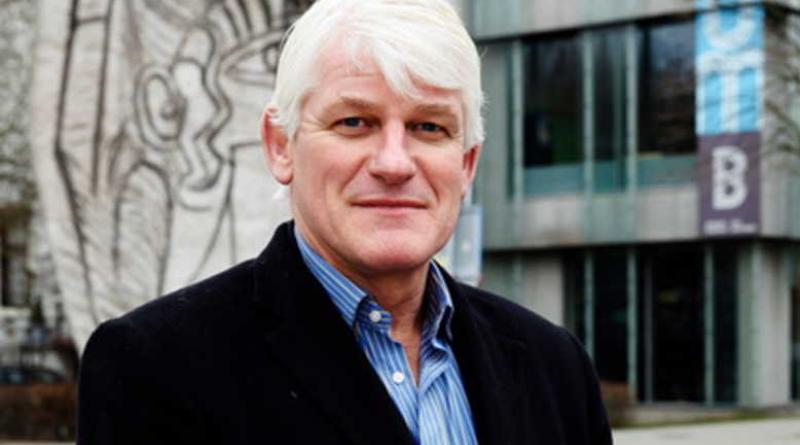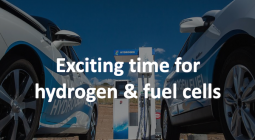The Paris Agreement Hinges on a European Hydrogen Economy.

After economic theorist Jeremy Rifkin predicted the rise of The Hydrogen Economy 17 years ago, history failed to cooperate with him. The US, then hooked on foreign oil and destined to run out of its own, developed hydraulic fracking and became a net oil exporter. Fossil fuel use increased globally, driven by demand in Asia. None of the fuel shortages or queues at petrol stations came to fruition, and neither did the emission-free hydrogen economy.
Hydrogen seemingly went into hibernation during the rise of solar panels, wind power, and electric vehicles, the darlings of green energy. Rifkin’s prediction seemed far off target—until recently.
True to form, hydrogen has exploded back on the scene with significant implications for climate change and the global economy. It has united a coalition of businesses that, absent the Paris Agreement and looming climate disaster, would have remained wed to fossil fuels. Instead, CEOs of the world’s major energy, automobile, aerospace, and industrial firms formed the Hydrogen Council at the World Economic Forum in 2017.
Hydrogen, we’re now told, is critical to the energy transition from hydrocarbons to zero carbon. Europe is becoming a field lab for hydrogen development. But is the rise of a hydrogen economy real this time? And if so, what will it mean for the world’s largest trading block?
The First Element
When hydrogen gained notoriety in the early 2000s, proponents billed it as a fuel for personal automobiles, which would stop at hydrogen stations for fuel cell refills. Critics warned that our streets would be clogged with mini-Hindenburg’s ready to ignite. The vision for hydrogen faded, and then came back stronger.
Scholars, governments, investors, and organisations like the International Energy Agency see hydrogen as the green solution for long-haul transport by truck, ship, and aircraft, not just cars. It can replace natural gas for heating and substitute for fossil fuels in iron and steel production. It’s also a viable feedstock for chemicals, concrete, and plastics. These latter applications involve combining carbon dioxide with hydrogen to form hydrocarbons we’d otherwise extract from the earth. Ideally, we capture the carbon dioxide and derive the hydrogen from water (more on that later).
Even better, hydrogen, like natural gas, can be moved through pipelines or containerised like liquid natural gas (LNG) for shipment by sea. Hydrogen pipelines could be built alongside existing natural gas lines, avoiding potential battles over land use.
Hydrogen hype has spread far beyond Davos. Research firm MarketsandMarkets estimates that the hydrogen market will expand from $135.5 billion USD in 2018 to $199 billion by 2023, with the highest growth rates coming from China, Japan, and South Korea. Wan Gang, China’s father of electric cars, recently told Bloomberg that “We should look into establishing a hydrogen society,” hinting that plans were already in action.
In July, Japan’s Kawasaki Heavy Industries announced that it had broken ground on a facility in Australia that will liquify and ship hydrogen to Japan by 2020. Meanwhile, rival carmakers Toyota and Honda are collaborating to expand fuel cell innovation and infrastructure in Japan. Prime Minister Shinzō Abe intends for hydrogen to be the star fuel of the 2020 Olympics Games, powering a 6,000-unit Olympic village.
If hydrogen is the miracle fuel it sounds like, what stands in the way of Europe adopting it?
Blue, Green, and Containerised
Today, hydrogen comes in two forms: blue, which depends on fossil fuels, and green, the carbon-zero version. If hydrogen is to help the world meet the Paris Agreement targets, it must evolve from blue to green. That has implications for how Europe will build a hydrogen economy.
Blue hydrogen is produced through steam methane reforming (SMR), a process by which steam reacts with methane from natural gas to generate hydrogen—and some carbon dioxide. The Union of Concerned Scientists asserts that SMR-derived hydrogen used in automobile fuel cells has a smaller carbon footprint than hydrocarbons used in an internal combustion engine. To be clear, SMR requires carbon capture storage, which is an expensive, unproven technology.
Green hydrogen, on the other hand, is made through electrolysis, a process that splits water into hydrogen and oxygen with virtually no carbon emissions. Whereas SMR is proven at scale, electrolysis is not. The vision is that electrolysis powered by solar, wind, hydropower, geothermal, or another renewable source would change that.
One promising electrolysis technique is the Iodine-Sulphur Cycle (I-S Cycle), a proven, three-step process that splits water in a reactor heated to at least 850 °C. The cost of renewable energy is the boundary condition for making it green. Renewable prices are falling at such a pace that I-S hydrogen could already be cost-effective in sun and wind-rich places.
It must be noted that other hydrogen production processes using algae, artificial photosynthesis, and biomass gasification (i.e., heating up plant material) are at the R&D stage. Toyota, for one, has partnered with the Dutch Institute for Fundamental Energy Research to create a device that can use sunlight to produce hydrogen from humid air. Green hydrogen hopefully scales soon. In the meantime, blue hydrogen would form the backbone of a hydrogen economy.
When the Price and Policy is Right
If all goes to plan, the world will build a hydrogen economy by starting with blue methods and progressing to green. Estimates place the break-even electricity price for electrolysis to match SMR at $0.03-0.04/kWh. There’s the right price, but what about policy?
In an “ambitious” scenario from Hydrogen Europe, a trade association, hydrogen would represent 24% of energy demand by 2050, enabling Europe to meet its Paris Agreement targets. The bulk of demand would come from transportation and heating for buildings, and the European hydrogen economy would generate some €820bn in annual revenue and 5.4mn jobs by 2050.
A few jurisdictions have given this scenario credibility. The H21 project in Leeds intends to convert an English city of 600,000 people to hydrogen power by 2026 simply by converting its natural gas infrastructure to hydrogen. Less impressive but far more memorable, a pasta factory in Italy made history this year when it cooked its pasta using a combination of hydrogen and natural gas that had been injected into the Italian gas grid as an experiment
Closer to my home, the Port of Rotterdam has begun its own ambitious experiment. On 2 July 2019, the Port debuted H-vision, a plan to convert Rotterdam from a historical fossil fuel hub into a centre for the production and distribution of blue, SMR-derived hydrogen. Eventually, H-vision hopes to produce green hydrogen by using electrolysis powered by energy from offshore wind farms or another clean source. The estimated total investment required for a blue hydrogen hub is €2bn with potential to reduce emissions by 16% by 2030 (based on Rotterdam’s 2018 industrial activity).
H-vision leaves Rotterdam with the task of figuring out how to store carbon emissions. Currently, the plan calls for Rotterdam, Antwerp, and Ghent to pipe carbon dioxide into porous sandstone located 3km below the seabed into empty North Sea gas fields. Whether that carbon dioxide will agree to stay in the rocks is an open controversy.
Here’s a consideration: several scientific bodies, including the Intergovernmental Panel and Climate Change (IPCC), have concluded that every path to contain global warming within the ideal 1.5°C target is impossible without carbon capture and storage technologies. Rotterdam may as well pioneer a solution if we want a fighting chance against climate change.
Geopolitics and Innovation
Public sentiment, policy, and innovation in Europe suggests that a hydrogen economy, supported by a partnership of private and public actors, could help to decarbonise the economy without throttling growth. Hydrogen plays nicely with the assortment of green technologies already deployed, including electric vehicles, which are limited to short-distance, lightweight transportation.
The challenge for Europe is to decide how and where green hydrogen ought to be sourced. Barring a revolution in hydrogen technology, Europe will need to import green hydrogen from abroad.
The Middle East and North Africa, with their solar power potential and proximity to Europe, are likely sources. Europe would remain dependent for energy on countries that may not have Europe or the climate’s best interests at heart. Oil states may choose to milk the cow of fossil fuels until it dies. Although the US, Canada, and Australia are bound to be major hydrogen exporters, liquified hydrogen will be more costly than piped hydrogen.
As such, the geopolitics of a European hydrogen economy are not ideal, but no worse than a hydrocarbon economy. Windfarms in the North Sea, like the proposed farm at Dogger Bank, might offer a workaround. The artificial islands built for these wind farms could, hypothetically, house facilities to produce and pipe hydrogen. Otherwise, high-efficiency power cables might transmit wind-generated electricity to mainland Europe for processing into hydrogen.
To an investor like myself, the technical and geopolitical challenges of hydrogen look like a massive opportunity for entrepreneurs, researchers, and policymakers. While I can’t claim to know how the hydrogen economy will play out—or if it will play out—I believe the Paris Agreement is consigned to failure unless hydrogen joins the renewable energy system. Jeremy Rifkin’s hydrogen economy may yet be vindicated.
Fred van Beuningen is an energy sector expert who currently serves as a Managing Partner at Chrysalix Venture Capital. For his full bio, please click here.
4 October 2019
ENERGY DIGITAL




